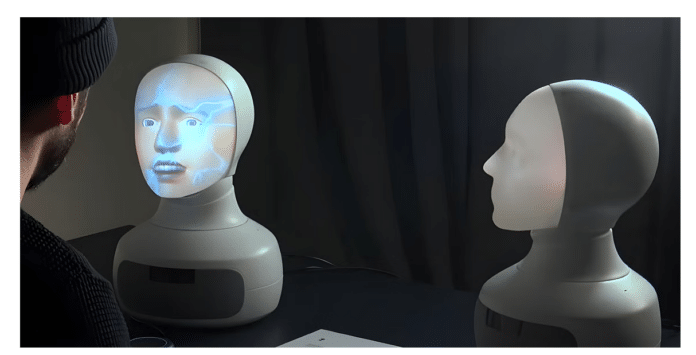Explore how this humanoid robot combines verbal and non-verbal communication, learn about its unique conversational process, and glimpse AI and robotics’s exciting, evolving future.
Researchers from Heriot-Watt University and Alana AI have introduced a robot receptionist driven by the advanced artificial intelligence (AI) model GPT-3.5 from OpenAI. This project, located within the UK National Robotarium, investigates the potential of large language models (LLMs) in human-machine interaction.
This robot goes beyond being a simple text-based conversational agent; it has a humanoid visage that includes animated eyebrows and a moving mouth. This unique configuration elevates interactivity by incorporating non-verbal signals, marking it as the pioneering creation to blend a domain-specific knowledge base seamlessly with verbal and non-verbal communication capabilities. Engineers have meticulously constructed a dedicated database by extracting data from the Robotarium’s website to mitigate the potential for disseminating inaccurate information. The robot relies on this database to respond more precisely to visitor inquiries.
From Speech to Lifelike Interaction
During conversations, the robot follows a specific sequence of actions. Initially, it transcribes the incoming speech into text, which accounts for the brief pauses observed during interactions. This delay results from the time required to convert spoken words to text and the subsequent processing for natural language understanding. Once this conversion is complete, the robot employs GPT-3.5 to formulate an appropriate response, then spoken aloud. At the same time, the robot mimics realistic facial movements and expressions, enhancing the overall interaction by providing a lifelike experience.
The execution is not without its imperfections. While the robot’s conversational tone checks the boxes for politeness and contextual comprehension, its delivery still retains an unmistakably robotic quality, akin to the conventional text-to-speech systems commonly found in smartphones. It’s crucial to recognise that these are still in the early stages of developing AI-powered robotic receptionists, and we can expect ongoing enhancements and refinements in the future.
The Evolution of Human-Robot Interaction
This project offers a glimpse into the swiftly evolving realm of AI and robotics. While the robot’s uncanny appearance may elicit mixed emotions, its presence marks the advent of an era where the utility of large language models like GPT-3.5 extends beyond text-based applications into the realm of intricate, human-like interactions. As technology progresses, we anticipate these robotic interfaces becoming increasingly nuanced and potentially indistinguishable from human receptionists. At this juncture, the future appears exciting and disconcerting for some. The robot receptionist at the UK National Robotarium signifies a bold stride into uncharted territory. While it may not be flawless, it demonstrates emerging technologies and a glimpse of what lies ahead in AI and human-machine relationships.
















































































